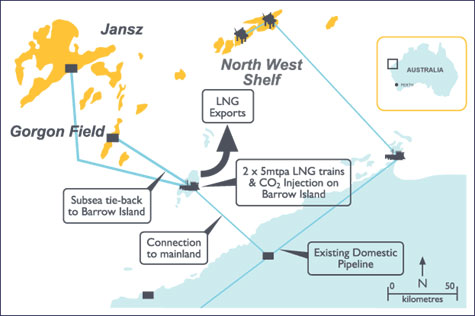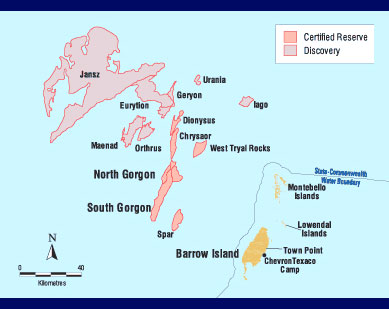and ExxonMobil
Move Ahead Down Under
With US$8.4-billion LNG project
 |
by ADAM BRUNS, Site Selection
Managing Editor
You've heard about the need for liquefied natural gas capacity in North America, and the dozens of LNG terminal proposals that need has engendered. And you've seen the ads touting those extremely safe LNG carriers. But you have to travel all the way upstream to get to the really big projects.
Much of the world's LNG will come from natural gas reserves in high-risk places like Qatar, Nigeria, Angola and Russia. Some will come from the coast of Western Australia, where Chevron, Shell and ExxonMobil have made recent progress in the planned US$8.4-billion (AU$11-billion) development of the Gorgon gas field.
The first gas won't be produced until 2010, but work on the Barrow Island project has been under way for some time, with in-principle approval coming in September 2003 and the passage of the Barrow Island Act by the Western Australian parliament in November 2003.
That planning has been bolstered by significant agreements, like Western Australia's pending $19-billion contract to sell LNG to China, and the April 2005 commitment by Gorgon investor Shell to purchase up to 2.5 million metric tons annually of the project's 10-million-metric-ton annual output, to be delivered to Shell's Energia Costa Azul terminal in Baja California, Mexico. The Gorgon investors are also targeting markets in Korea and Japan.
 |
The Gorgon project is just one of 74 advanced projects reported under construction or committed earlier this month by the Australian Bureau of Agricultural & Resource Economics (ABARE). Those projects have a cumulative value of $17.2 billion, and include ConocoPhillips' $2.3 billion, 3.5 million metric tons a year Darwin LNG plant (slated to produce 3.5 million metric tons a year) and an $839-million gas development project by Woodside Petroleum in Otway, both scheduled for completion in 2006. ABARE projects 2005 spending on minerals and energy exploration will rise by 23 percent to $1.6 billion.
The Gorgon development brings to mind astronomical associations, in both scale and name. First off, the Greater Gorgon field (which includes the deeper-water Jansz field) is estimated to contain some 40 trillion cubic feet (tcf) of gas. Gorgon proper has certified reserves of some 12.9 tcf, and includes fields named West Tryal Rocks, Spar, Chrysaor and Dionysus. West Tryal Rocks was the first discovery, in 1973. And more recent exploration in the deep water has uncovered new fields: Geryon, Orthrus, Urania, Maenad, Jansz and Io.
| Site Selection on Australia |
|
"What
the Aussie-U.S. Trade Agreement Will Mean," |
All of which lends an other-worldly feel to a decidedly earthbound proposition.
Those commitments were added to earlier this week when Western Australian Premier Geoff Gallop signed off on training centers in both China and Australia as part of the huge 25-year, $19-billion Australia-China Natural Gas Technology Partnership Fund, first established in 2002. Gallop said the first trainees had already begun a 28-week training program at the Australian Center for Natural Gas Management jointly run by The University of Western
|
"The establishment of this fund demonstrates our desire to develop long-term mutually beneficial partnerships with China across the energy sector, said Gallop. "WA's significant gas reserves could service the Guangdong contract for the next 750 years."
Meanwhile, final contract negotiations among the two nations and the corporations involved are yet to be cemented. Some speculate that past Chinese experience with high Australian iron ore prices is one reason for the delay. In addition, Australia is in a position of power with regard to China's power needs, being the lead coal supplier as well as a strong resource in the nuclear power industry — China aims to build 30 new nuclear power plants by 2020.
But LNG numbers are nothing to sniff at. According to an April 25 article in The Australian, "as China seeks to increase the LNG share of its energy sources from negligible to 10 per cent by 2015, it is estimated that the total cost of building the LNG infrastructure now planned will be $US50 billion."
Meanwhile, strong prices for natural gas continue to fuel Chevron earnings, and the reinvestment that the company continues to make in LNG projects worldwide. Among the gas projects cited during the company's first quarter earnings announcement were major investments in Nigeria, Angola, Trinidad and Tobago/Venezuela, the Gorgon project, the United Kingdom and Libya.
Chevron currently operates a fleet of approximately 30 oil and gas tankers. In May, the company ordered two LNG carriers from Korea-based Samsung Heavy Industries. Their planned delivery is in 2009, just about when the joint venture partners anticipate seeing the first Gorgon gas ready for shipment.
For more on LNG, see "Does LNG Spell Risk or Reward? ... Yes." from the March 2005 issue of Site Selection. And don't miss the Energy & Petrochemicals Industry Spotlight and Australia & New Zealand Spotlight coming in the July issue.
PLEASE VISIT OUR SPONSOR • CLICK ABOVE
Site
Selection Online
©2005 Conway Data, Inc.
All rights reserved. Data is from many sources and is not warranted
to be accurate or current.